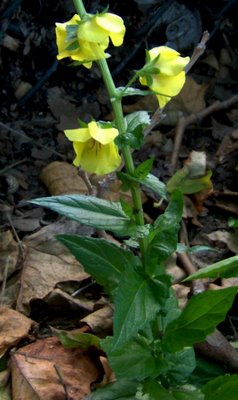
Another moist day moving through to evening is coming to a close viewed from the St. John's Sidewalk.
There had been some momentary nailbiters. One eyass jockeyed with another for a prime spot on the nest's edge. The first teetered, then wings up for balance, got her grip again. But now clouds low, light dimming, the hawks are quiet. The passers-by are few, and the hawkwatchers even fewer.
When suddenly I see a strange little splash of light beside the sidewalk. Something that seems to glow warm yellow in the gloaming.
I walk down Morningside, and there between the sidewalk and the chainlink fence...what?Evening Primrose? A stalk of petaled suns warming up a corner. Amazing. Here among the ice cream wrappers and tattered plastic bags, an actual living breathing native plant.
Did it grow here on it's own?
Had it's ancestors prospered and reproduced quietly on the grounds of the Cathedral running back a hundred, two hundred years. Back to the time when the plants that grew in what we call Manhattan, were the plants that had lived here for thousands of years? And their forebearers back and back and back? And after all those years of safe harbor, did this little seed jump the fence and begin to sink it's sturdy taproot, down and down and down, to make more seeds and start a colony of it's own?
Or is it even Evening Primrose?

Oenohera biennis
It has been a while. But then again, this is one of those sturdy native plants that one sees often enough growing in roadsides, in fields, in disurbed earth in parts of the country where plants have leave to do what comes natural, that one might remember. But I've never seen it in Manhattan merrily growing on it's own. A part of some horticultural native plant display, if then.
Perhaps some Manhattanite, with a packet of "wildflower" seeds, a few seasons back is the cause.
It's possible.
And this is a plant whose seeds are dearly loved by birds. And birds can fly from a long way away, where they had eaten their fill of Evening Primrose seed and then stopped for a rest in St. John's rose bushes. And perhaps one of the those previously eaten seeds made it all the way through the system without being pulverized. And what does a bird often do just before it takes flight?
It's possible.
But I'd rather think that this yellow adventurer, out to start it's own colony of hardy adventurous plants, is the product of a long line of local primroses that have grown on Cathedral Hill for millennia upon millennia. And in the bad times of monocultured lawns, flower beds, herbicides, and weekly lawn mowing, that these plants with the sturdy taproot, whose yellow blossoms do not open until the evening, knew how to wait and bided their time.
And why not? What with the crafty adaptations and the arrival of the amazing Urban Red-tailed Hawks, why not a bid from the botanical world on the part of the amazing Urban Evening Primroses?
Why not indeed.
2 comments:
I love this entry, Donna -- love how you expressed it. Boy oh boy, can you write!
I am the grass; I cover all.
I am the grass.
Let me work.
Carl Sandberg
Thanks for the beautiful comments. You are a wonderful observer and writer. I have oenothera berlandieri which grows in the cracks where my driveway joins the side walk and blooms so beautifully--a huge amount of leaf and bloom coming through a 1/8th inch crack! Sometimes this adventurous and hardy plant sneaks out into the cracks where the asphalt joins the concrete street gutter. The street sweeper comes by and pulverizes it and it grows back. Under our houses and sidewalks and lawns and paving and parking lots lies 12 feet of top soil--supposedly the deepest and richest in this country--the Oxnard Plain.
Betty Jo McDonald
Post a Comment